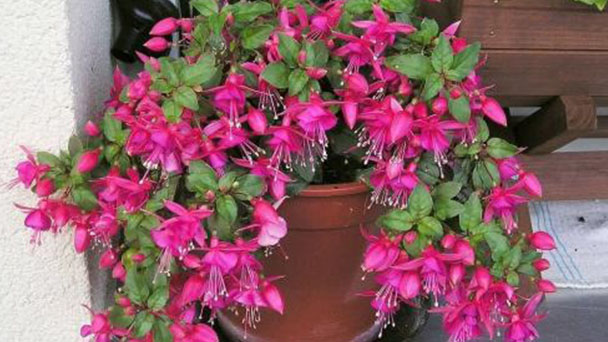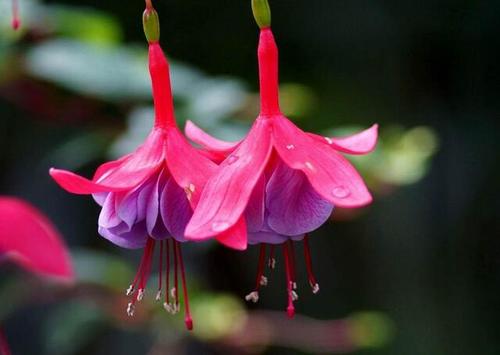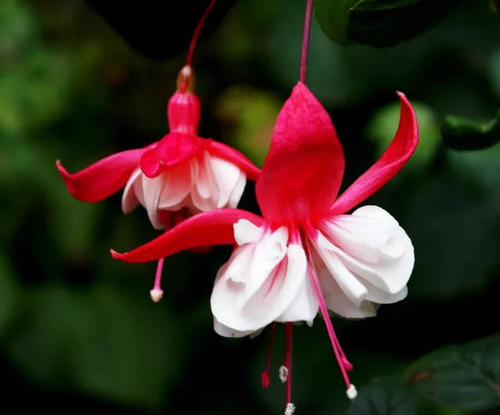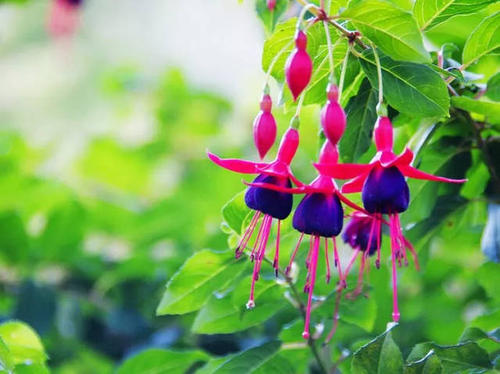Fuchsia profile
Written by Maggie
Oct 28 2021

Fuchsia has a peculiar flower shape and is extremely elegant. Fuchsia is often potted for decorative balconies, windowsills, study, etc., but also hanging in the anti-theft net, gallery frame and other places to watch, small shape, pleasing to the eye.
Fuchsia picture
Growth habits of Fuchsia
Fuchsia likes a cool, humid environment, afraid of high temperature and strong light, can not bear the summer heat and wind and rain. Therefore, winter requires warm and humid, sunny, air circulation; In summer, dry, cool and semi-cloudy conditions are required, and certain air humidity is maintained.
Fuchsia, like other flowers, needs the right soil to grow. With fertile, loose micro-acid soil, and should be rich in humus, good drainage.
When the temperature reached 30℃ in summer, the growth of Fuchsia was extremely slow, and a large number of withered and died at 35℃. Winter temperature is not low at 5℃, weak below 5℃, it is vulnerable to freezing damage.
Fuchsia morphological characteristics
Fuchsia is a semi-shrub, stems erect, 50-200 cm tall, 6-20 mm thick, much-branched, pubescent and glandular-hairy, glabrous when old, young shoots reddish. Leaves of the Fuchsia are opposite, ovate or narrowly ovate, 3 -- 9 cm long, 2.5 -- 5 cm wide, larger in the middle, apex acuminate, base shallowly cordate-shaped or obtuse, margin with distantly shallow teeth or odontoids, veins often reddish, lateral veins 6 -- 11 pairs, annulate near the margin, pubescent on both surfaces especially lower veins; Petiole of Fuchsia is 2-3.5 cm long, often reddish, pubescent with glandular hairs; Stipules are narrowly ovate to subulate, ca. 1.5 mm long, caducous.
Flowers of Fuchsia are bisexual, simple, rarely born in pairs in axils of apex leaves of stems and branches, pendulous; Pedicels are slender, greenish or reddish, 3 -- 7 cm long; Flower tubes of Fuchsia are red, tubular, larger distally, 1 -- 2 cm long, 3 -- 5 mm in diameter, with pedicels sparsely pubescent and glandular hairs; Fuchsia has 4 sepals, red, oblong-lanceolate or triangular-lanceolate, 2 -- 3 cm long, 4 -- 8 mm wide, apex tapering, reflexed when open; Petals are variegated, purplish, red, pink, and white, arranged imbricate, broadly obovate, 1-2.2 cm long, apex concave; Fuchsia has 8 stamens, longer of outer wheels, filaments red, 1.8 -- 3 cm long extruding from the tube, anthers purplish red, oblong, 2-3 mm long, ca. 1 mm in diameter, pollen pink; Ovary is obovate-oblong, 5 -- 6 mm long, 3 -- 4 mm in diameter, sparsely pilose with glandular hairs, 4-loculed, with numerous ovules in each locule; Style of Fuchsia is red, 4 -- 5 cm long, surrounded by a green shallow cup-shaped disk at base; Stigma is clavate, brown, ca. 3 mm long, ca. 1.5 mm in diameter, apical 4-lobed. Fruit of Fuchsia is purplish red, obovate oblong, ca. 1 cm long.
The geographical distribution of Fuchsia
Fuchsia is native to Peru, Chile, Argentina, Bolivia, Mexico and other Central and South American countries; Fuchsia is widely cultivated in China, especially in the north or in the northwest, southwest plateau greenhouse growing, has become an important flower plant.
Fuchsia propagation methods
The rod inserts the reproduction mainly. In addition to the hot summer, it can be carried out throughout the year, with spring planting the fastest.
Choose the growth of robust branches, each section has 2~3 stem nodes, leaving a pair of leaves above, the base at the near node oblique shear, all immersed in 0.1 potassium permanganate solution bubble for 30 seconds, in the upright exposed Fuchsia leaves, the base continues to bubble for 30 minutes. After taking it out, brush it with clean water, and then keep it in clean water for 24~48 hours before inserting the rod. The density should not be covered by the leaves.
Cutting seedlings of Fuchsia should be transplanted as soon as possible after taking root. The root should not exceed 2 cm in length. First, the cuttings were planted with plain soil (50% garden soil and 50% river sand) in a small pot to promote root growth. Vegetarian soil is less irritating to young roots and is beneficial to their survival. After planting, pour two times of permeable water, row tightly in a shallow basin, place Fuchsia in half shade. Details on how to propagate Fuchsia Plant.

Fuchsia growing methods
Light
Fuchsia likes the semi-overcast environment, but in different seasons have different lighting requirements. Winter and early spring, late autumn need full sunshine, early summer and early autumn need half sunshine, hot summer should shade.
The temperature
The temperature at which Fuchsia plant grows is 10-28℃, and the temperature in summer cannot exceed 30℃, and a large number of Fuchsia wither and die at 35℃. Therefore, cooling should be done well in summer. Winter requires sufficient sunshine, the culture temperature can not be lower than 5℃, otherwise it will cause freezing damage, must take insulation measures.
Humidity
Spray water to the leaf surface and the ground several times a day to reduce the temperature and increase the air humidity.
Fertilization
Fuchsia plant because of fast growth, flowering times, so in the growing period to master the thin fertilizer application, about every ten days once a thin cake fertilizer or compound fertilizer. The basin soil should be dry before fertilization. After fertilizing, spray water with a fine sprinkler to avoid sticking to the surface of the fertilizer and decay.
Prevention and control of diseases and pests of Fuchsia
Fusarium wilt and rust often occur, with 20% wilting rust emulsion 400 times the liquid spray prevention and control of rust, with 10% acetic acid solution (antimicrobial agent 401) 1000 times the liquid applied into the soil prevention and control of wilt.
If ventilation is not good, aphids, scale insects and mealworms can also occur, which can be sprayed with 40% oxidized diethoate emulsion 1000 times liquid.
Fuchsia main value
Fuchsia has a peculiar flower shape and is extremely elegant. Potted plants are used to decorate balconies, windowsills, study rooms, etc., and can also be hung on anti-theft nets, gallery racks and other places for viewing.
The fuchsia flower language
Believe in love, warm heart.

Read Next:
Top 10 Most Beautiful Roses in the World
Top 10 Most Beautiful Flowers in the World
26 Best Autumn Flowers to Plant for Fall Color in Garden
Latest Updated
- Benefits of Bugleweed - 7 Science-backed Health Benefits
- Bugleweed Dangers & Side Effects - Is It Poisonous?
- How to Plant Evergreen Trees - What You Should Know
- When to Plant Evergreens - Grow Guide for Evergreen Trees
- 12 Wonderful Evergreen Shrubs for Your Garden
- 12 Popular Evergreen Plants with Pictures for Beginners
- When And How To Prune A Lilac Bush Like a Pro
- How to Grow & Care for Lilac Vine (Hardenbergia Violacea)
- Japanese Lilac Tree (Syringa Reticulata) Care & Propagation Guide
- Shumard Oak Pros and Cons - What to Know
Popular Articles
- Winter maintenance of Antirrhinum Majus
- How to Grow Terminalia Mantaly Tree
- How to Grow and Care for Crossostephium Chinense
- How to grow Antirrhinum Majus in spring
- Peristeria Elata (Dove Orchid) Profile: Info & Care Guide
- Underwatered Snake Plant (Sansevieria Trifasciata) - Signs And How To Fix
- How to Care for Brazilian Jasmine Plant (Mandevilla Sanderi)
- How to Grow & Care for Graptopetalum Purple Delight in Summer
- Rosa Chinensis (China Rose): Plant Growing & Care Tips
- How to Care for Baby Sun Rose (Aptenia Cordifolia)
